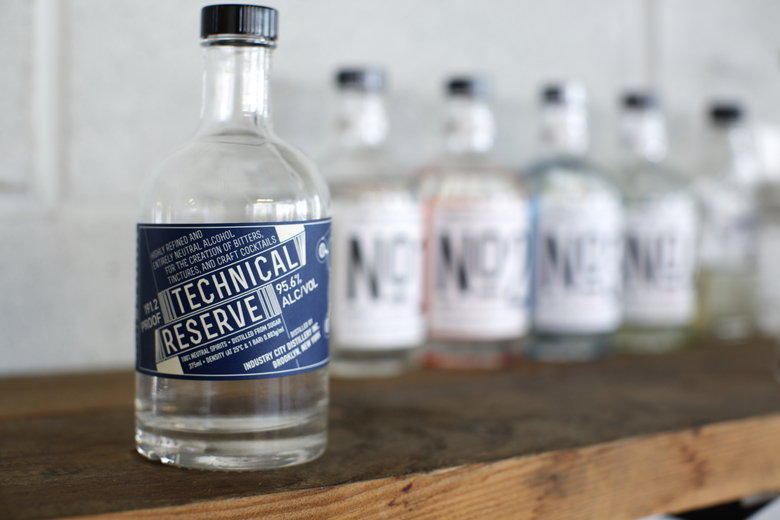David Kyrejko and Zac Bruner of Sunset Park’s The City Foundry greet visitors at the doors of Industry City Distillery to showcase their latest project: Technical Reserve. Outside, the sun glints off the water on a sunny day. The Statue of Liberty nods a not-so-tipsy welcome through the windows. Light bounces in to illuminate the dusty rooms of this hundred-year old warehouse, now repurposed into a bustling mecca for science, noughties craftsmanship and a fair amount of self-professed geekery. Scratchy, the distillery cat joins in the greeting and tries to climb her way up an unsuspecting leg before deciding the log sitting nearby makes for a more willing scratching post. Ahead is a gray hallway with locked doors and mysterious array of machines.
The equipment and nearby glass-paned distillery may look sinister but there are no mad scientists here. Instead this is an experiment in very good taste. For these are the hallowed walls and corridors of the Distillery’s first project, Industry Standard Vodka, now three years old and New York City’s only vodka distillery.
Now the pair have followed their motto of “pursuing better craft spirits through science” by launching another venture. Their new product is a 191.2% proof (96.5% ABV) spirit designed to serve as a base for bitters, cocktail infusions, cooking ingredients, perfume and just about anything else. It’s also the highest proof spirit distilled in America, made in Industry City Distillery’s custom-built glass fractioning still.
The still was designed and built by The City Foundry, David and Zac’s first and core project. The Foundry is a research and development group focused on improving small-scale manufacturing through art and science. Special equipment was required to get the separation power and distillation purity required for Technical Reserve. Fractional distillation removes trace impurities, eliminates odors and bitter flavor compounds leaving a neutral spirit base suitable for any added ingredient. Even the cap closing the bottles is made of Teflon™ to prevent interaction with the liquid contents.
Despite the science, Kyrejko stresses Technical Reserve is designed to be an all-purpose craft spirit rather than standalone beverage. Sweet flavors such as vanilla work just as well as savory, in most cases even better than regular tinctures as the addition of water (the commercial method) can create bitter notes. Using a strong alcohol base facilitates the process of capturing the subtlest of flavors. Water can then be added to lower the alcohol proof if desired without compromising flavor.
That fact probably hasn’t escaped the lucky few to have purchased the current limited supply of the Reserve. Customers include cocktail connoisseurs and limoncello makers as well as perfumers, chefs and intrepid food entrepreneurs.
Industry City Distillery showed us how to make two bitters bases using Technical Reserve and ingredients usually available year-round at your local market. This process can be used to infuse the flavor of many ingredients including cooking spices, which can then be added to a hot pan at the start of cooking to add the flavor of herbs and spices.
Allspice dram bitters
Allspice dram is a traditional way to add warming spices to cocktails or cooking. This recipe from Industry City Distillery can be used two ways: either as a concentrated allspice dram bitters or made into the full traditional recipe.
This version of the traditional liqueur produces a lighter color, less astringency and bitter notes than usual due to Technical Reserve’s high proof.
If making as a bitters, use half the quantity of ingredients and omit water and sugar steps.
Preparation Tips:
- 1 milliliter of water is 1 gram — however, 1 milliliter of Technical Reserve is 0.8 gram. Use your kitchen scale as an accurate volume measure if you don’t have a graduated cylinder.
- If making bitters, use half the quantity of ingredients then omit water and sugar steps.

Equipment:
1 lemon peeler
1 kitchen scale
1 set of kitchen scales
1 pestle and mortar (recommended) or spice grinder
1 micro-plane or zester
1 500-750 ml glass jar or bottle with a lid for steeping (No plastic containers or jars with gummy plastic lids. Liquor bottles are fine.)
1 graduated cylinder (highly recommended) or measuring cup
1 medium funnel (no plastic)
1 mesh strainer that will fit inside that funnel
Large coffee filter paper or qualitative medium filter paper (preferred)
1 750ml liquor or wine bottle for bottling
1 dropper bottle (if making allspice dram bitters)

Ingredients:
250 ml Technical Reserve (If using another alcohol, allow twice as long steeping time.)
50 g allspice
6-7 individual peppercorns
10-11 cloves
1 small cinnamon stick (5-6 g)
Half a nutmeg
1 lemon peel (About 1” x 3”)
300 g sugar (Use brown sugar for a little more color and a caramel-like flavor.)
400 ml water

- Using the pestle and mortar, crush and grind the allspice, peppercorns, cinnamon and cloves into a medium-coarse powder.
- Add the ground ingredients and lemon peel to the steeping jar.
- Measure 30 ml of Technical Reserve, pour into the pestle and mortar and use the pestle to stir the liquid around and “wash” all of the residual flavor off of the mortar.
- Pour this infused liquid into your steeping jar using the funnel.
- Repeat the mortar wash one more time using 30 ml of Technical Reserve (This is the benefit of using the pestle and mortar over a spice grinder).
- Pour 140 ml of Technical Reserve into your steeping jar and screw on the lid.
- Shake the steeping jar and let sit for 6-10 days shaking as often as possible. The more you shake, the quicker the steep.
- When you’re done steeping, it’s time to filter out the allspice dram concentrate. Nest your mesh strainer in the funnel and place a paper coffee filter on top of that. Use a little Technical Reserve to wet down the paper if it won’t stay put.
- Place the funnel and filter in the top of the 750ml bottling bottle.
- Slowly pour the contents of the steeping jar into the coffee filter, trying to keep the spice grounds in the jar.
- Pour an additional 50ml of Technical Reserve in the steeping jar with the spice mixture and shake vigorously for a minute. Pour through the filter paper, trying to reserve the grounds.
These steps will give you allspice dram bitters. Pour the strained liquid into a dropper bottle and use. Just a few drops per drink should do it. Experiment!
To finish the recipe as a traditional allspice dram, add water and sugar:
- Measure 100ml of water and pour into the steeping jar. Let sit 5-10 minutes as if making tea then pour contents into the filter. Let fully drain and discard the filter.
- Combine 350g sugar with 300ml water to make a syrup. Bring to a boil, cool and add to your concentrate.
- Done! Allspice Dram is strong stuff. ¼ ounce is usually enough for most cocktails.
The remaining bitters can be kept out of the refrigerator in the sealed pipette indefinitely.
Lavender Extract Base
This base blends well into numerous drinks such as tea, cocktails and water seltzers. Lavender is very potent and only a couple drops are enough to impart flavor. As a rule of thumb, use 5-10 drops of finished extract for every drink.
Equipment
1 200 ml glass jar and lid (preference given to PTFE or Teflon™ coated lids)
1 small funnel
1 100 ml dropper container, or any other small bottle
Coffee filters or qualitative medium filter paper (preferred)
1 graduated cylinder (preferred) or measuring cup
Ingredients
6 g dried lavender (or 18 g fresh lavender)
50 ml Technical Reserve (or enough to cover the lavender)
Prepare
- Add the lavender into the glass jar.
- Add 30 ml Technical Reserve into the same jar (enough to cover the lavender but no more).
- Seal the jar and shake to distribute.
- Let steep for 1-2 days out of direct sunlight. Shake often.
- Place filter paper in funnel and wet down with a little bit of Technical Reserve. Place the funnel into your 100 ml decanting bottle.
- Pour the contents of the steeping jar through the filter and allow to drain fully.
- Measure 20 ml Technical Reserve. Pour through the pre-steeped lavender in the filter. Again, let the liquid drain fully. At this point the lavender can be discarded.
- Stopper your container with the liquid and keep out of direct sunlight.
Photo credit: Clay Williams



